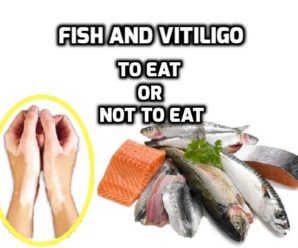
Fish and Vitiligo (leucoderma) : To eat or not to eat
Eating good quality fish is beneficial for vitiligo because they provide healthy omega 3 fatty acids (EPA and DHA) to reduce inflammation and improve gut health and brain functioning.
The awesome health benefits of Omega 3 fatty acids to treat various autoimmune health issues are well researched, including type 2 diabetes, ulcerative colitis, rheumatoid arthritis, eczema, psoriasis and vitiligo. (1, 2, 3, 4, 5)
Read more: Are fish oil supplements good for vitiligo?
How Omega 3 fatty acids will help in Vitiligo?
Vitligo (also called as leucoderma) refers to loss of natural skin color which is an autoimmune skin condition. The faulty immune system mistakenly attacks the pigment (color) producing skin cells to cause skin de-pigmentation in the form of white patches on various parts of the body. This autoimmune reaction is accompanied by chronic inflammation and poor gut health because more than 70% of the immune system lies in your gut. (7) Hence, improving gut health and reducing inflammation are key to control vitiligo symptoms. Also, not to forget, all autoimmune health issues are triggered by chronic stress. Hence, improved brain functioning is also crucial.
Let’s understand how omega 3 fatty acids can help with all these 3 concerns:
- Reduce inflammation– According to Berry Sears, Ph.D., omega 3 fatty acids decrease the already existing cellular inflammation in the human gut and beyond by inhibiting the action of certain enzymes which produce pro-inflammatory substances. Moreover, they further decrease the cause of inflammation if consumed in the long term. (8)
- Treat Leaky gut syndrome and improve gut health– The human gut refers to the complete gastro-intestinal tract from mouth to the anus. Poor gut health is often linked to autoimmunity. Leaky gut refers to the phenomenon when the walls (lining) of the gut get damaged at small intestine and allows toxins (undigested food, harmful microbes and heavy metals) to pass through and enter the blood stream to trigger autoimmune reaction. Omega 3 fatty acids improve the structural integrity of the gut walls by providing flexibility and receptivity to the membranes of the cells in the gut wall. (9) The reduced gut inflammation also plays its part in reversing the gut damage.
- Improves the gut flora to reduce autoimmunity– The human gut contains trillions of microbes which govern the immune system. The optimum balance of healthy microbes (probiotics) and harmful microbes (pathogens) is very crucial to keep the system in order. In case of autoimmunity, this equilibrium gets disturbed either due to lack of healthy microbes or due to overpopulation of unhealthy ones such as Candida (yeast overgrowth). There are research evidences to prove that DHA can help improve the diversity of gut flora to re-establish the gut microbes equilibrium. (10, 11)
- Natural immunomodulators– Omega 3 fatty acids are potent immunomodulators who alter the immune system’s response naturally to prevent any further destruction of melanocytes. (12)
- Helps combat stress, depression to improve mental health– DHA, also termed as an essential brain food, constitute around 60% of your brain’s total fat content. It is absolutely critical to have enough of DHA in your diet to combat chronic stress and anxiety which is quite common among people with autoimmune issues including vitiligo. Omega 3 fats are proven to be beneficial in treating depression disorders as well. Hence, regular intake of enough DHA can improve brain power and mental health. (13, 14, 15)
- Anti-obesity effect– When combined with regular physical workout, omega 3 fats help prevent accumulation of excessive body fat. Also, they promote breakdown of cellular fats to get rid of existing extra body fat. (16, 17, 18)
Fish is the best source of healthy omega 3 fatty acids
Omega 3 fatty acids, also known as ‘essential’ healthy fats, are essential nutrients which the human body cannot synthesize by its own and depends on external dietary sources to meet the requirements.
Omega 3 fatty acids can be categorized into 3 main types as below:
- ALA (Alpha-linolenic acid)
- EPA (Eicosapentaenoic acid)
- DHA (Docosahexaenoic acid)
When we discuss the health benefits of Omega 3 fats, we are actually talking about EPA and DHA. (19) The EPA is primarily beneficial in reducing inflammation and DHA is primarily responsible for better brain functioning and nervous system. Together, they improve the overall gut health to calm down the immune system and control vitiligo symptoms. Interestingly, EPA and DHA are also known as ‘marine’ omega 3 fatty acids because they are mainly coming from fish.
ALA doesn’t have much health benefits of its own and it is mainly used to meet the energy requirements of the body. However, a part of it (around 10-15%) further converts into EPA and DHA to contribute towards health benefits.
In short, if you are keen to include omega 3 fatty acids in your diet, eating good quality fish is the best way for it.
How much fish per week for vitiligo healing?
Fish is a low-calorie animal protein with lesser saturated fats and cholesterol- easier to digest than other animal proteins like red meat, beef and pork. Along with Omega 3 fats, fish provide protein, vitamin A, vitamin D and minerals (calcium, selenium, zinc and potassium) in good amounts.

Various government institutions recommend eating 2 servings (3- 4 ounces per serving) of contaminants free, fatty fish per week for healthy heart and general well-being. (20, 21) In case of a stubborn, autoimmune skin condition like vitiligo, we need to eat at least 4 to 6 servings (more than 12 ounces) of cold water, wild caught, fatty fish per week to get a decent amount of EPA and DHA to fight autoimmunity.
How to choose good quality fish?
The characteristics of good quality fish are:
- High concentration of omega 3 fats (prefer fatty fish)
- Free from pollutants and contaminants
- Wild caught instead of farm fish
- Cold water fish instead of warm water fish
Prefer Fatty fish
Varieties like salmon, trout, mackerel, sardines, anchovies, herring, tuna (fresh), carp, trout and whitebait are few examples of oily fish. They have a high concentration of healthy omega 3 fatty acids along with vitamin D.
A few of the oily fish contains edible bones which can prove a good source of calcium and phosphorus.
Avoid contaminated fish
Fish, being a water dwelling animal, can gobble the toxic pollutants like mercury, PCBs and other pollutants from industrial wastage and oil spills. When you eat that fish, that toxic substance can enter your body to create all sorts of trouble. So, it is always better to avoid larger varieties of fish having longer life spans- they tend to contain higher levels of mercury toxicity than others.
Fish varieties to avoid due to high mercury toxicity (As per the guidelines of USDA):
- Shark
- Swordfish
- Tilefish
- King mackerel
- Marlin
- Tuna yellowfin (ahi)
Tune albacore (white tuna) should also be consumed in limited quantities due to mercury contamination.
Wild fish vs Farm fish
- Wild fish is low in saturated fats and calories than farm fish with comparable omega 3 fats.
- Due to limited space to swim, farm fish is more prone to diseases and hence, given antibiotics as and when required. Also, sometimes, color is added to them to give a healthy color. These antibiotics and synthetic colors can be detrimental to your health.
- In case of farm fish, there is more control on water quality, hence the chance of mercury contamination is less in farm fish. But, if you avoid the above mentioned contaminated varieties of fish, all other varieties of wild caught fish are quite safe to use.
In short, wild caught fish should be preferred.
Cold water fish vs Warm water fish
The omega 3 fats content is higher in cold water fish than the warm one as they store a thick layer of fat to keep themselves warm in extreme cold water conditions.
Cold water fish are more frequently found in oceans, whereas warm water fish is frequently found in small water bodies such as lakes, rivers, streams and oceans as well. Thus, the mercury content may also be higher in cold water fish.
In short, cold water fish with least mercury contamination should be preferred.
Tuna, herring, salmon, mackerel and sardines are examples of healthy types of cold-water fish.
Fish oil vs Fish for vitiligo
Don’t worry if you don’t eat fish regularly or you can’t just meet the weekly requirements. The high quality fish oil supplements can provide EPA and DHA easily to assist in your vitiligo healing journey. Moreover, if you are concerned about the mercury and other pollutants in fish, fish oil of a reputed brand is the safe bet in that case.
In fact, I recommend all the people with vitiligo to take fish oil supplements for at least a period of 6 months to get significant improvement in their skin condition. You can read my full article here.
Can eating fish cause or trigger Vitiligo?
Sounds weird?
Yeah, I can understand that because in this whole article we have discussed good quality fish as a healthy food source for vitiligo healing. So, how can fish cause or trigger vitiligo?
Well, in Ayurveda and some other traditional health systems, it is believed that consuming fish and dairy products (milk and yogurt) together should be avoided as they are incompatible with each other and may cause sudden, drastic chemical changes in the body to cause blood impurity, terrible allergies and even vitiligo.
The modern medical science doesn’t support these claims and in so many parts of the world, fish dishes are prepared with dairy products and people freely consume fish and dairy products together without any documented evidences of vitiligo or any other serious health issue.
However, fish and milk are among the leading foods which causes food allergies. Hence, as a precautionary measure, a person with vitiligo may choose not to eat these two foods together or immediately one after the other.
You can read my detailed opinion about this topic here.
Having said that, good quality fish, when eaten in a proper manner doesn’t cause or trigger vitiligo at all.
Conclusion
Eat 12 to 16 ounces of wild caught, cold water, fatty fish per week. Avoid fish varieties with high mercury content. Fish can be broiled, baked, steamed and poached- avoid frying. People who can’t meet these targets should consume the fish oil supplements to get the desired dosage of healthy omega 3 fats. Apart from omega 3 fatty acids, other crucial dietary supplements for vitiligo healing are Vitamin D, Vitamin B12, turmeric, zinc and glutamine.


